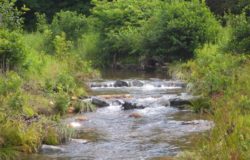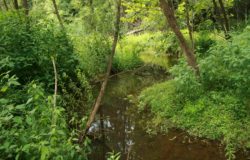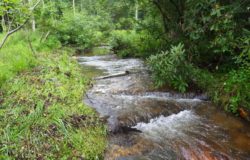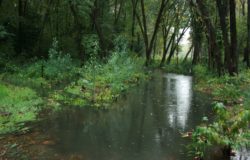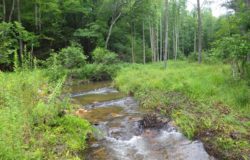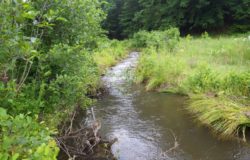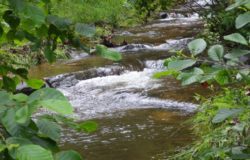About
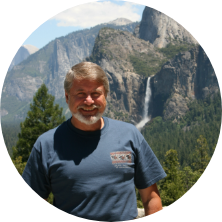
Mr. Rocky O. Powell, the founder of Clear Creeks Consulting, received a BS in Biological Sciences/Ecology and an MS in Biological Sciences/Aquatic Ecology from Towson University. He completed additional training and coursework in hydrology, open channel hydraulics, fluvial geomorphology and engineering practices.
He has over forty-four years in the environmental field and offers the firm’s clients a unique blend of experiences that include wildlife and fisheries research; biological stream surveys; water quality monitoring; stream habitat assessment and enhancement; natural resources protection; watershed management; wetland delineations and functional assessments; wetland restoration/creation; stream bank bioengineering; geomorphologic stream assessments; stream restoration and stabilization design utilizing the natural channel design approach; local, state and federal permitting; construction management; public outreach and teaching.
His extensive training and experience have provided him with a solid understanding of ecological, geomorphological, engineering principles and practices. This knowledge, in addition to his years of project management and construction experience, allow him to guide each project through the various phases to a successful completion. It also provides him with the ability to overcome constraints or problems encountered during the life of a project.
He directed a regulatory division that conducted environmental impact assessments to determine the impact of commercial and residential development, public infrastructure, recreational facilities, agricultural operations, timber harvesting and surface mining on watersheds, streams, wetlands, and floodplains. He was instrumental in developing local regulations for the protection of streams, wetlands, and floodplains. He also developed environmental guidance documents in support of those regulations.
He provided permit coordination and environmental technical support services for state and federal permitting of public infrastructure projects (e.g. roads, culverts and bridges, sanitary sewers, etc.). These support services included: natural resource inventories, wetland delineations and functional assessments; impact analyses and alternatives analyses; preparation of NEPA documents, Special Area Management Plans (SAMPS) and wetland mitigation plans.
Utilizing the Rosgen Stream Classification and Stability Assessment Methodology for more than thirty years, he has conducted hundreds of geomorphic watershed and stream assessments in Maryland, Virginia, West Virginia, North Carolina, Pennsylvania, New York, Vermont, and Texas.
He has developed numerous watershed management plans that included restoration/management strategies, rehabilitation measures and best management practices in Maryland, Pennsylvania, Virginia and West Virginia.
He has designed, permitted, provided construction management and post-construction monitoring for dozens of wetland creation/mitigation and more than 167,000 linear feet of stream restoration/relocation projects in Maryland, West Virginia, Virginia, Pennsylvania, New York, and North Carolina.
He has developed regional hydrologic and hydraulic geometry curves for use in geomorphic stream assessment and restoration in the Piedmont and Coastal Plain regions of Maryland and North Carolina, the Appalachian Plateau region of West Virginia, the Ridge and Valley region of Virginia and Pennsylvania, and the Catskill and Adirondack regions of New York.
Mr. Powell was a project manager for several major, federally funded projects focused on evaluating geomorphic assessment methodologies, developing regional curves for channel stability ratings, and evaluating stream restoration projects in Maryland. He has also served on various regional interagency task groups that evaluated mitigation techniques for mountaintop mining and evaluated the existing U. S. Geological Survey stream gage network.
As an instructor in the Johns Hopkins University, School of Continuing Studies, he taught graduate and undergraduate courses on stream ecology and stream related issues. He has presented numerous training workshops, short courses, and seminars on stream dynamics, watershed protection and management, geomorphic stream assessment, and the fluvial geomorphologic design approach to stream restoration throughout the United States and Canada.
His favorite free time activities include cheering at Baltimore Ravens games and exploring national parks and tropical destinations with his wife, Valarie and son, Cody An avid outdoorsman, he enjoys scuba diving, fishing, white water rafting, canoeing, hiking, and camping. He resides with his family in Jarrettsville, Maryland.
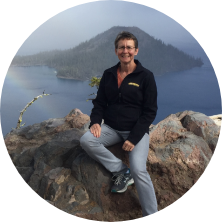
Ms. Valarie M. Klein earned both a BS and MS in Biology from Towson University, focusing her course work in ecology. She completed additional training in wetland delineations and forest stand delineations.
She has over 17 years in the environmental field and offers the firm’s clients a unique blend of experiences that include aquatic research; biological stream surveys; water quality monitoring; natural resources protection; watershed management; wetland delineations; local, state and federal permitting; public outreach, environmental education, and teaching.
As a public employee, she was responsible for review of development proposals to ensure technical accuracy and compliance with local, state, and federal environmental regulations. Specifically, this review involved environmental impact assessments to determine the impact of commercial and residential development, public infrastructure, recreational facilities, agricultural operations, timber harvesting and surface mining on watersheds, streams, wetlands, and floodplains.
Additionally, she provided permit coordination and environmental technical support services for state and federal permitting of public infrastructure projects (e.g. roads, culverts and bridges, sanitary sewers, etc.). These support services included: natural resource inventories and wetland delineations; impact analyses and alternatives analyses.
Ms. Klein has also developed environmental guidance documents for government review staff and private consultants, as well as office/financial procedural manuals for several non-profit organizations.
Dedicated to promoting science literacy, she has served as an environmental educator for student field trips at a local nature center, and has experience implementing lesson plans for elementary and middle school students. As part of her commitment to promoting educational opportunities for children, and fostering a strong local community, she has served as both a volunteer and a board member for various non-profit organizations.
Ms. Klein enjoys spending time with her husband, Rocky and adult son, Cody as well as get-togethers with extended family and friends. In addition to doing projects around the house, she is an avid reader, a fitness enthusiast, and an animal lover. Her two dogs love to accompany her on long walks and while she works in the yard. She enjoys travel, and she and her husband plan to visit all 61 national parks.
Mission Statement
You don’t need to be an ecological professional to recognize a stable, functioning riparian ecosystem. The appealing character of a stable stream draws you to it. Walking along its banks you anticipate and often experience a chance encounter with a Great Blue Heron or Kingfisher hunting for fish. Peering into the clear waters you can enjoy watching schools of dace, chubs or minnows maneuvering in unison along the bottom of the deep pool in front of you. Listening to the rhythm of the flowing water as it runs its course around and over the cobble and boulder substrate of a riffle is a soothing experience that invites you to linger and enjoy the moment.
Our approach to restoring stream, wetland, riparian meadow and forest ecosystems is often referred to as a blend of art, science and engineering. Our goal is to recreate and restore natural landscapes that provide habitat where plant and wildlife communities can thrive and people come away with an emotional connection to the surrounding landscape they have just encountered. We accomplish this by studying and understanding natural, functioning riparian ecosystems and using them as a guide in developing our designs for restoration projects.
Over many years we have developed a collaborative relationship with highly qualified and experienced surveyors, engineers, scientists and planners. This allows us to select a team of professionals whose expertise is best suited to the needs of any client and individual project. We also team with construction contractors we know and trust on specific design-build projects. Our involvement in all phases of our projects (planning, assessment, design, permitting and construction management) has significantly contributed to our long-term record of success.
Philosophy
As we go about our business of managing and restoring landscapes let’s all heed this advice …
“Everyone ought to be dissatisfied with the slow spread of conservation to the land. Our “progress” still consists largely of letterhead pieties and convention oratory. The only progress that counts is that on the actual landscape of the back forty, and here we are slipping two steps backward for each forward stride.” Aldo Leopold – The Ecological Conscience, 1947.
“The practice of conservation must spring from a conviction of what is ethically and esthetically right, as well as what is economically expedient. A thing is right only when it tends to preserve the integrity, stability, and beauty of the community, and the community includes the soil, waters, fauna, and flora, as well as people.” Aldo Leopold – The Ecological Conscience, 1947.
“There is no theory of river action and behavior to guide river improvement. We in the United States have acquiesced to the destruction and degradation of our rivers, in part because we have insufficient knowledge of the characteristics of rivers and the effects of our actions that alter their form and process.” Luna Leopold – View of the River, 1994.
“We all tend to learn directly from the past experience of trial and error, but if we do not understand – if we do not take a closer, quantitative look at our rivers over time – we have a tendency to unknowingly repeat the errors of the past. For the good of the river, as well as our profession, we have to remove ourselves from the darkness of some of those desk bound offices and spend more time in the field.” Dave Rosgen – Applied River Morphology, 1996.
Over more than forty years in the environmental field, I’ve learned that despite our best efforts natural systems are complex and often unpredictable and they will always teach us that persistence and humility are virtues. As environmental professionals we must strive to learn more, understand better, and improve our craft so that we can make a real difference. We owe it to our kids and the earth to leave it a better place than it was when we entered it. – Rocky Powell
